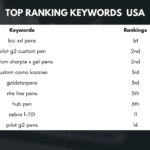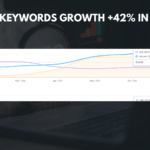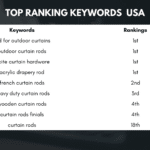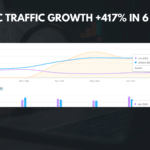
|
Getting your Trinity Audio player ready... |
In today’s global market, businesses are increasingly recognizing the importance of reaching a multilingual audience. With the rise of the internet and the ability to connect with people from all over the world, it has become crucial for businesses to optimize their websites for different languages. This is where multilingual SEO strategies come into play.
Multilingual SEO, or search engine optimization, refers to the process of optimizing a website to rank higher in search engine results for multiple languages. It involves understanding the target audience, conducting keyword research, creating multilingual content, optimizing the website, building backlinks, and measuring the success of the strategy.
The importance of multilingual SEO cannot be overstated. With more than half of internet users speaking a language other than English, businesses that do not cater to these audiences are missing out on a significant portion of potential customers. By implementing multilingual SEO strategies, businesses can expand their reach and tap into new markets.
Key Takeaways
- Multilingual SEO strategies are essential for reaching a global audience and increasing website traffic.
- Understanding your target audience is crucial for effective multilingual SEO, including their language preferences and search habits.
- Keyword research is a critical component of multilingual SEO, requiring careful consideration of language nuances and regional differences.
- Creating high-quality, relevant, and engaging multilingual content is key to attracting and retaining visitors to your website.
- Optimizing your website for multilingual SEO involves technical considerations such as hreflang tags, URL structure, and site speed.
The Importance of Multilingual SEO for Website Reach
1. Benefits of Multilingual SEO for website reach
Implementing multilingual SEO strategies can have several benefits for a website’s reach. Firstly, it allows businesses to target specific language-speaking audiences and tailor their content accordingly. This increases the chances of attracting relevant traffic and potential customers.
Secondly, multilingual SEO can help improve the visibility of a website in search engine results pages (SERPs) for different languages. When a website ranks higher in SERPs for multiple languages, it becomes more accessible to users searching in those languages. This can lead to increased organic traffic and higher conversion rates.
2. How Multilingual SEO can increase website traffic and conversions
By optimizing a website for multiple languages, businesses can attract a wider audience and increase their website traffic. When users search for keywords in their native language, they are more likely to click on websites that appear in their search results. This can lead to an increase in organic traffic and potential customers.
Furthermore, multilingual SEO can also improve conversion rates. When a website is available in a user’s native language, they are more likely to trust the content and feel more comfortable making a purchase or taking the desired action. By providing a seamless user experience in multiple languages, businesses can increase their chances of converting visitors into customers.
Understanding Your Target Audience for Multilingual SEO
1. Importance of understanding your target audience for Multilingual SEO
Understanding your target audience is crucial for the success of any marketing strategy, including multilingual SEO. By understanding the demographics, preferences, and behaviors of your target audience, you can create content that resonates with them and optimize your website accordingly.
Different cultures and languages have unique search patterns and preferences when it comes to online content. By understanding these nuances, businesses can tailor their multilingual SEO strategies to meet the specific needs and expectations of their target audience. This can result in higher engagement, increased conversions, and improved customer satisfaction.
2. How to identify your target audience for Multilingual SEO
To identify your target audience for multilingual SEO, you can start by analyzing your existing customer base. Look at the demographics, language preferences, and geographic locations of your current customers to get an idea of who your target audience might be.
You can also conduct market research to gain insights into the preferences and behaviors of potential customers in different regions. This can involve surveys, focus groups, or analyzing data from online platforms and social media.
Once you have identified your target audience, you can use tools like Google Analytics or social media analytics to gather data on their online behavior and preferences. This data can help inform your multilingual SEO strategy and ensure that you are effectively reaching and engaging with your target audience.
Keyword Research for Multilingual SEO
| Metrics | Description |
|---|---|
| Keyword Volume | The number of times a keyword is searched for in a specific language and location. |
| Keyword Difficulty | A metric that measures how difficult it is to rank for a specific keyword in a specific language and location. |
| Keyword Relevance | A metric that measures how relevant a keyword is to the content on a specific page or website in a specific language. |
| Keyword Diversity | A metric that measures the variety of keywords used on a specific page or website in a specific language. |
| Keyword Intent | A metric that measures the user’s intent behind a specific keyword search in a specific language. |
1. Importance of keyword research for Multilingual SEO
Keyword research is a crucial step in any SEO strategy, including multilingual SEO. By identifying the keywords and phrases that your target audience is using to search for products or services, you can optimize your website to rank higher in search engine results for those keywords.
When conducting keyword research for multilingual SEO, it is important to consider the language and cultural nuances of your target audience. Different languages may have different ways of expressing the same concept or idea. By understanding these nuances, you can choose the most relevant and effective keywords for each language.
2. How to conduct keyword research for Multilingual SEO
To conduct keyword research for multilingual SEO, you can start by brainstorming a list of relevant keywords and phrases in your target languages. This can involve using tools like Google Keyword Planner or other keyword research tools to generate keyword ideas.
Next, you can use these keywords to analyze search volume and competition. Tools like SEMrush or Ahrefs can provide insights into the popularity and competitiveness of specific keywords in different languages.
Once you have identified the most relevant and effective keywords for each language, you can incorporate them into your website’s content, meta tags, URLs, and other on-page elements. This will help improve your website’s visibility in search engine results for those languages.
Creating Multilingual Content for Your Website
1. Importance of creating multilingual content for your website
Creating multilingual content is essential for effectively reaching and engaging with a multilingual audience. By providing content in multiple languages, businesses can cater to the preferences and needs of different language-speaking users.
Multilingual content also helps improve the user experience by providing information in a user’s native language. This can lead to increased trust, engagement, and conversions. Additionally, multilingual content can help businesses establish themselves as authoritative sources in different markets and build brand loyalty among diverse audiences.
2. Tips for creating effective multilingual content
When creating multilingual content, it is important to consider the cultural and linguistic nuances of your target audience. Here are some tips to create effective multilingual content:
– Use native speakers or professional translators to ensure accurate translations and cultural appropriateness.
– Adapt the content to suit the preferences and expectations of each language-speaking audience.
– Consider the length and structure of the content, as different languages may require different formatting.
– Optimize the content for relevant keywords in each language.
– Provide localized information, such as pricing, shipping options, and contact details, to cater to specific markets.
By following these tips, businesses can create multilingual content that resonates with their target audience and effectively communicates their message across different languages.
Tips for Optimizing Your Website for Multilingual SEO

1. Best practices for optimizing your website for Multilingual SEO
Optimizing your website for multilingual SEO involves several best practices that can help improve its visibility and accessibility in different languages. Here are some tips for optimizing your website:
– Use hreflang tags to indicate the language and country targeting of each page.
– Create separate URLs or subdomains for each language version of your website.
– Optimize meta tags, URLs, headings, and alt tags with relevant keywords in each language.
– Ensure that your website’s navigation is user-friendly and intuitive for multilingual users.
– Provide language switchers or flags to allow users to easily switch between different language versions of your website.
By implementing these best practices, businesses can ensure that their website is optimized for multilingual SEO and provides a seamless user experience for users in different languages.
2. How to ensure your website is user-friendly for multilingual users
In addition to optimizing your website for search engines, it is important to ensure that it is user-friendly for multilingual users. Here are some tips to make your website more user-friendly:
– Provide clear navigation and intuitive menus that are easy to understand and navigate in different languages.
– Use clear and concise language that is easy to understand for non-native speakers.
– Avoid using idioms, slang, or cultural references that may not be familiar to users in different languages.
– Ensure that your website is mobile-friendly and responsive, as many users access the internet through mobile devices.
– Test your website’s performance and load times in different languages to ensure a smooth user experience.
By prioritizing user-friendliness and providing a seamless experience for multilingual users, businesses can increase engagement, conversions, and customer satisfaction.
Building Backlinks for Multilingual SEO
1. Importance of building backlinks for Multilingual SEO
Building backlinks is an important aspect of any SEO strategy, including multilingual SEO. Backlinks are links from other websites that point to your website and are considered a vote of confidence by search engines. They can help improve your website’s authority and visibility in search engine results.
When it comes to multilingual SEO, building backlinks from websites in different languages can help improve your website’s visibility and relevance in those languages. By obtaining backlinks from reputable websites in different regions, you can increase your chances of ranking higher in search engine results for specific keywords in those languages.
2. How to build backlinks for Multilingual SEO
To build backlinks for multilingual SEO, you can start by conducting competitor analysis to identify websites that are linking to your competitors’ websites. This can involve using tools like Ahrefs or Moz to analyze the backlink profiles of your competitors.
Next, you can reach out to these websites and offer them valuable content or resources that they can link to. This can include guest blogging, creating infographics or videos, or providing expert insights or interviews.
Additionally, you can also leverage social media platforms and online communities to build relationships with influencers or industry experts in different languages. By collaborating with these individuals or organizations, you can increase the chances of obtaining backlinks from their websites or social media profiles.
By implementing these strategies, businesses can build a strong backlink profile for their multilingual SEO strategy and improve their website’s visibility and authority in different languages.
Measuring the Success of Your Multilingual SEO Strategy
1. How to measure the success of your Multilingual SEO strategy
Measuring the success of your multilingual SEO strategy is crucial to understand its effectiveness and make data-driven decisions. Here are some metrics and tools that can help you measure the success of your strategy:
– Organic traffic: Monitor the organic traffic to your website from different language versions to see if it is increasing over time.
– Conversion rates: Track the conversion rates for different language versions of your website to see if they are improving.
– Keyword rankings: Monitor the rankings of your website for relevant keywords in different languages to see if they are improving.
– Bounce rate: Analyze the bounce rate for different language versions of your website to see if users are engaging with the content.
– Tools: Use tools like Google Analytics, Google Search Console, or third-party SEO tools to gather data and insights on your multilingual SEO performance.
By regularly monitoring these metrics and analyzing the data, businesses can gain insights into the effectiveness of their multilingual SEO strategy and make informed decisions to optimize their website further.
2. Tools for tracking Multilingual SEO performance
There are several tools available that can help businesses track and analyze the performance of their multilingual SEO strategy. Here are some popular tools:
– Google Analytics: Provides insights into website traffic, user behavior, conversions, and other key metrics.
– Google Search Console: Allows businesses to monitor their website’s performance in search engine results, including impressions, clicks, and keyword rankings.
– SEMrush: Provides comprehensive SEO analytics, including keyword research, backlink analysis, and competitor analysis.
– Ahrefs: Offers insights into backlink profiles, keyword rankings, and competitor analysis.
– Moz: Provides tools for keyword research, link building, and website optimization.
By using these tools, businesses can gain valuable insights into the performance of their multilingual SEO strategy and make data-driven decisions to improve their website’s visibility and reach in different languages.
Common Mistakes to Avoid in Multilingual SEO
1. Common mistakes to avoid in Multilingual SEO
While implementing a multilingual SEO strategy, it is important to avoid common mistakes that can negatively impact your website’s visibility and reach in different languages. Here are some common mistakes to avoid:
– Poor translation: Using automated translation tools or non-native speakers for translations can result in inaccurate or poorly translated content. This can lead to confusion, mistrust, and a negative user experience.
– Duplicate content: Creating duplicate content across different language versions of your website can result in penalties from search engines. It is important to create unique and relevant content for each language.
– Ignoring cultural nuances: Failing to consider the cultural nuances and preferences of your target audience can result in content that is irrelevant or offensive. It is important to adapt your content to suit the cultural expectations of each language-speaking audience.
– Neglecting local SEO: Multilingual SEO should not only focus on optimizing for different languages but also consider local SEO factors such as local keywords, directories, and citations. Neglecting these factors can limit your website’s visibility in specific regions.
– Lack of ongoing optimization: Multilingual SEO is an ongoing process that requires regular monitoring, analysis, and optimization. Failing to continuously optimize your website for different languages can result in a decline in visibility and reach.
2. How to prevent these mistakes from negatively impacting your Multilingual SEO strategy
To prevent these mistakes from negatively impacting your multilingual SEO strategy, it is important to prioritize accuracy, relevance, and user experience. Here are some tips to prevent these mistakes:
– Use native speakers or professional translators for accurate and culturally appropriate translations.
– Create unique and relevant content for each language version of your website.
– Conduct thorough keyword research and adapt your content to suit the preferences and expectations of each language-speaking audience.
– Implement local SEO strategies to optimize your website for specific regions and languages.
– Regularly monitor and analyze the performance of your multilingual SEO strategy and make data-driven decisions to optimize your website further.
By following these tips, businesses can prevent common mistakes and ensure that their multilingual SEO strategy is effective in reaching and engaging with their target audience in different languages.
The Future of Multilingual SEO
The future of multilingual SEO is promising as businesses continue to recognize the importance of reaching a global audience. With the increasing globalization of markets and the rise of internet usage in non-English speaking countries, multilingual SEO will play a crucial role in expanding businesses’ reach and tapping into new markets.
To stay ahead of the curve in multilingual SEO, businesses should continue to prioritize user experience, relevance, and accuracy. By understanding their target audience, conducting thorough keyword research, creating high-quality multilingual content, optimizing their website, building backlinks, and measuring the success of their strategy, businesses can effectively reach and engage with a multilingual audience.
As technology continues to evolve, it is also important for businesses to stay updated on the latest trends and tools in multilingual SEO. This can involve keeping up with search engine algorithm updates, exploring new technologies like voice search or artificial intelligence, and leveraging data analytics to make data-driven decisions . Additionally, businesses should also consider the importance of localization in their SEO strategies. This includes translating and optimizing content for different languages and cultures, as well as understanding the nuances of each target market. By staying informed and adapting to these trends, businesses can ensure that their websites are visible and accessible to a global audience, ultimately driving more traffic and increasing their online presence.
If you’re interested in expanding your online presence globally, you may want to check out this informative article on Multilingual SEO Strategies. It provides valuable insights and tips on how to optimize your website for different languages and target international audiences effectively. In addition, if you’re curious about Facebook’s offices in India and their locations, you can explore this interesting article that reveals where they are located and their addresses. For those looking to understand more about spam and its impact on digital marketing, this comprehensive article on spam is a must-read. Lastly, if you’re considering blogging as a career path, this insightful article discusses the pros, cons, and how to decide if it’s the right choice for you.
FAQs
What is Multilingual SEO?
Multilingual SEO is the process of optimizing a website’s content to rank higher in search engine results pages (SERPs) for multiple languages and regions.
Why is Multilingual SEO important?
Multilingual SEO is important because it helps businesses reach a wider audience and increase their visibility in different regions. It also helps improve user experience for non-native speakers by providing content in their preferred language.
What are some Multilingual SEO strategies?
Some Multilingual SEO strategies include conducting keyword research for each language, creating unique content for each language, using hreflang tags to indicate language and regional targeting, and optimizing meta tags and URLs for each language.
What are hreflang tags?
Hreflang tags are HTML tags that indicate to search engines which language and region a webpage is targeting. They help search engines serve the correct version of a webpage to users based on their language and location.
What is the difference between Multilingual SEO and International SEO?
Multilingual SEO focuses on optimizing a website’s content for multiple languages, while International SEO focuses on optimizing a website’s content for multiple countries and regions. Multilingual SEO is a subset of International SEO.























































